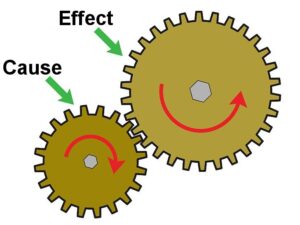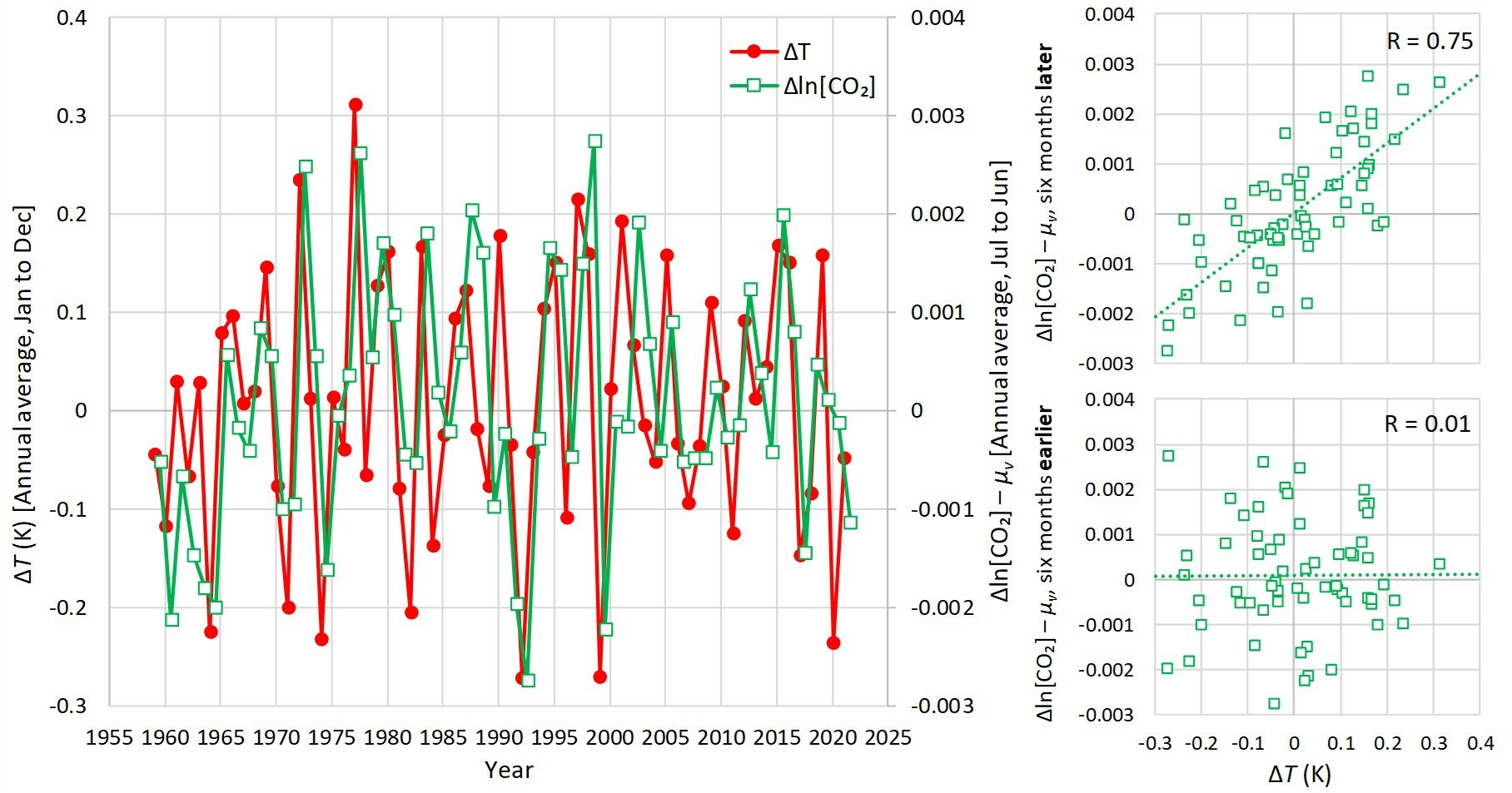
Unfortunately, science often does not follow common sense. I use quantum mechanics in my field of research all the time, and it violates common sense at every turn. Nevertheless, I am forced to use the theory because the data strongly support it. Thus, even though “it makes sense” that rising carbon dioxide levels will increase the earth’s temperature, we don’t know that for a fact. Indeed, the majority of the data have consistently shown that this is not the case. Several analyses of ice-core data show that on long time scales, the average temperature of the earth rises, and then carbon dioxide levels rise (see here, here, here, and here).
Now, of course, all these studies use proxies to estimate global temperature, and that can be tricky. In addition, producing the time scale involves making several unverifiable assumptions. Thus, I have never put much stock in such studies. However, others who are interested in climate change (aka Global Warming) take these data seriously. They generally say that these long-term trends are showing the effects of changes in earth’s orbital cycle, which changes the energy it gets from the sun. Thus, they aren’t relevant to what is happening right now. Also, there are at least some ice-core analyses that show carbon dioxide rising before temperature does. In other words, it’s complicated.
However, a recent study (which actually builds on two previous studies) looked at the modern data that has been collected for carbon dioxide levels in the atmosphere and global temperature. In other words, it analyzed what is happening right now. Of course, there are several sets of data for global temperatures, and they don’t really agree with one another, but the authors used a well-accepted one. What they found is that even on this relatively short time scale, carbon dioxide levels rise after temperatures rise. In fact, here are three graphs from the abstract:

From the graph on the left, it is clear that temperature (red line) rises first, then carbon dioxide level (green line) rises. The other two graphs show this even more convincingly. On those two graphs, changes in carbon dioxide and temperature are only correlated with one another if you consider the change in carbon dioxide level after the change in temperature, not before.
But wait a minute. How can temperature affect carbon dioxide level? Well, one of the major places the earth stores carbon dioxide is in the ocean (and, to a lesser degree, in fresh water). When temperatures go up, carbon dioxide becomes less soluble, so the oceans release carbon dioxide. From that point of view, it “makes sense” that rising temperatures will cause rising carbon dioxide levels. But once again, science doesn’t always make sense. Thus, it’s probably very complicated. Most likely, rising temperatures cause rising carbon dioxide levels, and those rising carbon dioxide levels cause more rising temperatures.
Which is more important? If you trust this study, it’s the former. In their appendix, the authors estimate that the increase in atmospheric carbon dioxide levels caused by increasing temperature is three times greater than the increase in carbon dioxide levels caused by human emissions. Now, of course, that still means human emissions increase temperature. However, it also means that (not surprisingly) the global climate models aren’t properly taking this into account. As a result, global climate models are exaggerating humanity’s contribution to global warming. While I think that has already been well-established, this study gives at least one of the explanations for it.

I recently listened to an interview with Dr Paul Homan and his theory is that water vapor is far far more relevant to the greenhouse effect and that C02 is negligible. He uses an example of putting on 1 blanket to increase your warmth vs putting on 10 blankets, eventually the extra warmth you get from an extra blanket diminishes greatly. But he also acknowledged that C02 is necessary to keep us from freezing which confuses me how both of those things could be the case. What are your thoughts?
Water vapor is a much stronger greenhouse gas than carbon dioxide. That’s because it absorbs more wavelengths of infrared radiation. This website shows that:
https://webbook.nist.gov/cgi/inchi?ID=C7732185&Type=IR-SPEC&Index=0
Scroll down to the graph. This is called water vapor’s IR spectrum. The x-axis is the wavelength (actually, wave number, but don’t worry about that) of the infrared radiation, and the y-axis shows you how much of that wavelength is absorbed. The farther down on the graph, the more absorption. Notice that absorption takes place at a wide range of wavelengths, and for many of them, it is really strong. Compare that to carbon dioxide:
https://webbook.nist.gov/cgi/cbook.cgi?ID=C124389&Type=IR-SPEC&Index=1
Once again, scroll down to the graph. Notice that the number of wavelengths that carbon dioxide absorbs is less, and for one group of wavelengths, the amount of absorption is pretty low.
So…without any carbon dioxide in the air, none of those wavelengths get absorbed, and the earth loses all that energy to outer space. Once you put carbon dioxide in the air, those wavelengths start getting absorbed, but since there aren’t a lot of wavelengths, it doesn’t take many carbon dioxide molecules to absorb them all. Once you have enough carbon dioxide molecules to absorb all those wavelengths, any extra carbon dioxide won’t do anything, because there is nothing left to absorb. Thus, there is some level of carbon dioxide that leads to the most energy absorbed, and after that, no matter how much more you add, no more energy will be absorbed.
For water, since there are so many wavelengths it can absorb, it takes a lot more water molecules to absorb all the possible energy that can be absorbed by water. At the same time, however, water vapor doesn’t stay in the atmosphere very long. It condenses out in the form of clouds and then rain. As a result, it shouldn’t have much of a long-term effect on global warming. However, as global temperature rises, more water vapor will stay in the air longer, and that will cause more energy to be trapped and thus more warming. However, that’s a secondary effect (much like the effect this study shows carbon dioxide produces), so it isn’t thought to be a major player in global warming. However, as this study seems to indicate, it probably isn’t so simple.
That was a very helpful explanation thank you!
Good word.
Common sense or not, the axiom, “Correlation does not imply causation,” is basically true, though correlation can indicate causation. What it doesn’t do is show what causes what. In fact, many times correlation may indicate a third (or more), uncontrolled factor that is doing the causing. As you’ve demonstrated, I think that’s what’s happening here.
Similarly, untruth doesn’t indication intention. It could indicate honest error. It could indicate a third agent who is intentionally misleading some to honestly lie, that is, they believe that a lie is true and pass it on as truth. Like the correlation above, we don’t know for sure but can suspect.
True, but one thing we know for sure is that cause must always come before effect. Thus, if carbon dioxide levels increase AFTER temperature increases, they can’t be causing those temperature increases.
Hi Dr. Wile,
This is rather interesting, however, I do have a question. This idea that natural changes in earths temperature (Milankovitch cycles) dominated past climate changes makes sense to me, as it seems CO2 levels were dependent on temperature change caused by external factors. Yet, considering that CO2 does warm the earth, and we are producing it independently of the Milankovitch cycles, wouldn’t it be safe to conclude that humanity will warm the earth? According this museum article (https://samnoblemuseum.ou.edu/understanding-extinction/mass-extinctions/end-permian-extinction/#:~:text=What%20caused%20the%20extinction%3F,likely%20causes%20of%20the%20extinctions.) the Permian extinction event occurred partly because of warming caused by the release of greenhouse gasses from temperature independent sources (volcanoes). It is interesting that CO2 wasn’t the deciding factor in earth’s climate for the majority of the past, but does this really change our view when considering our own effects on climate?
Thank you!
Just Another Image Bearer
Yes, it is definitely safe to say that humanity warms the earth, but the question is by how much? If the natural increase in CO2 caused by naturally increasing temperature is three times what humanity does (as this study suggests), that means humanity’s contribution is small. Thus, we probably shouldn’t be killing a lot of people to reduce our CO2 output. That’s the real issue with global warming. Cheap energy saves lives, and all attempts at reducing CO2 emissions lead to higher energy prices, which lead to more human death. Now…if we know that global warming will lead to even more deaths, then we probably ought to start reducing our CO2 emissions regardless of the fact that it kills people. However, we need to be VERY sure that more people will die by global warming than by increasing energy prices. Right now, it appears reducing CO2 emissions will kill a lot more people than the global warming caused by people.